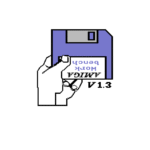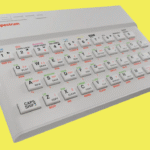A Raspberry Pi and Greaseweazle floppy drive adapter can be used together to read and image Amiga disks.
Pulling an old Amiga 1200 out of a box and hoping it will work is always worrying. If it turns out the board is ruined (sub-standard capacitors were used on original A1200s, prone to leaking), you’re left with a heavy keyboard.
But as you can see in this video (by Rob Fisher), there is an alternative. A mass-produced set of boards you can place in your Amiga case.
While seemingly a standard Amiga 1200 (in fact a replica case), this machine actually has a Raspberry Pi inside it. We’re not talking PiStorm here, either. No, this computer is running an Amiga operating system, emulated on the Raspberry Pi.
The Amiga’s keyboard, meanwhile, is connected to the Pi via a USB HID device, specifically intended for projects like this. It’s also suitable for various other devices, and compatible with the A500 Mini, too.
Raspberry Pi and Greaseweazle in action
As for the disks, they’re inserted into the drive as normal. The difference is that the drive itself is connected to a Greaseweazle board. This is an IDE and USB interface for 3.5-inch drives, capable of reading Amiga format disks. You can learn more about this on the Greaseweazle project’s Github page.
In this video, you can see the project up and running:
Here, the Raspberry Pi is running Pimiga 3. That’s a Raspberry Pi operating system, Linux based, but which hosts Amiga software, including the classic stuff.
In many ways, I’ve posted this for myself. Aside from little spare time, I own countless Raspberry Pis. I have a couple of floppy disk drives; oh, and I have a ton of classic 3.5-inch Amiga disks. Significantly, I also have a Greaseweazle, bought on eBay, but I’ve yet to try it out properly.
Seeing this up and running, however, is pretty exciting. Realising that the Raspberry Pi and Greaseweazle can now be used in this way opens some possibilities. If you’re dreaming of Amiga action but can’t afford an old computer, don’t worry. A working Amiga is now achievable with a Raspberry Pi, Greaseweazle, and an old 3.5-inch drive.
What now for my Greaseweazle?
Due to work and physical space constraints, my Greaseweazle remains sat in an anti-static bag. This has been the case since it popped through the letterbox and I ordered a suitable (I hope) ribbon cable. My original intention had been to simply connect the device to my computer and image all the non-game disks.
But now I’m staring a new Raspberry Pi project in the face…
Affiliate Disclosure: Some of the links in this post may be affiliate links, which means I may earn a small commission if you make a purchase through those links. This comes at no extra cost to you. Thank you for your support!
Christian Cawley is the founder and editor of GamingRetro.co.uk, a website dedicated to classic and retro gaming. With over 20 years of experience writing for technology and gaming publications, he brings considerable expertise and a lifelong passion for interactive entertainment, particularly games from the 8-bit and 16-bit eras.
Christian has written for leading outlets including TechRadar, Computer Weekly, Linux Format, and MakeUseOf, where he also served as Deputy Editor.
When he’s not exploring vintage consoles or retro PCs, Christian enjoys building with LEGO, playing cigar box guitar, and experimenting in the kitchen.









